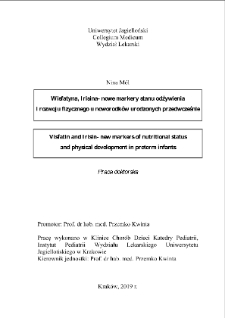Obiekt
Tytuł: Visfatin and Irisin - new markers of nutritional status and physical development in preterm infants
Abstrakt:
This study assessed the role of selected markers of nutritional status, visfatin and irisin, and evaluated if type of feeding may affect body composition of preterm newborns born with very low birth weight (VLBW). The biochemical analyses (irisin and visfatin concentration in blood and human milk) were performed during the 1st week of life and in the 5th week of life. Body composition using bioimpedance analysis was assessed during the 1st week of life and at the predicted time of birth in VLBW group, while in the control full term group – during the 1st week and 3rd month of life. VLBW neonates fed with milk formula had lower amount of fat free mass, increased amount of fat tissue than VLBW newborns fed with breast milk and full term newborns.The VLBW neonates showed statistically lower serum irisin concentration compared to their full term counterparts. Its concentration during the 1st week of life was positively associated with the weight, length, head circumference at birth, and weight and head circumference at 5th week of life. Visfatin concentration at 5th week of life was negatively associated with body weight, body length and head circumference at birth. There was a strong negative association between irisin and visfatin concentrations during the 1st week, and at 5th week. Visfatin concentration in the breast milk of the VLBW mothers increased between the first and seco ; nd analysis, and it was statistically increased in the 5th week after the delivery. Irisin and visfatin concentrations in breast milk at 1st analysis were positively associated with their corresponding measurements at 2nd time.
Miejsce wydania:
Stopień studiów:
Dyscyplina:
Instytucja nadająca tytuł:
Promotor:
Data wydania:
Identyfikator:
Sygnatura:
Język:
Prawa dostępu:
Kolekcje, do których przypisany jest obiekt:
Data ostatniej modyfikacji:
26 cze 2023
Data dodania obiektu:
5 lut 2021
Liczba wyświetleń treści obiektu:
30
Liczba wyświetleń treści obiektu w formacie PDF
0
Wszystkie dostępne wersje tego obiektu:
http://dl.cm-uj.krakow.pl:8080/publication/4394
Wyświetl opis w formacie RDF:
Wyświetl opis w formacie OAI-PMH:
| Nazwa wydania | Data |
|---|---|
| ZB-132172 | 26 cze 2023 |
Obiekty
Podobne
Mól, Nina
Gilarska, Maja
Olszewska, Marta
Ochoda-Mazur, Agnieszka
Grudzień, Andrzej
Janeczko, Magdalena

